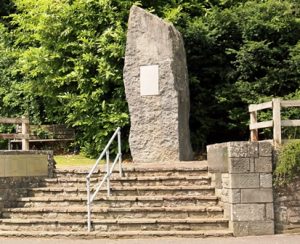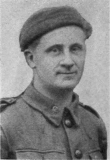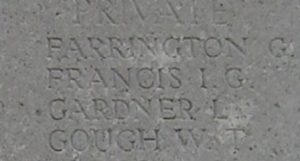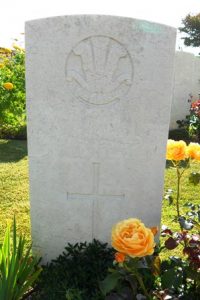Cwmdu, or Llanfihangel Cwmdu, is a small village and community situated in the heart of the Black Mountains in Breconshire. The village is located on the A479 Talgarth to Tretower road. The men of the village who fell during the Great War are commemorated on the Crickhowell and District War Memorial, which is located in Crickhowell near the location of the old Crickhowell War Memorial Hospital.

The Great War, 1914-1918
John Vaughan Edwards, Corporal, 235066, Royal Gloucestershire Hussars. John was the son of Walter Edwards and Sarah Jane Edwards (nee Richards), of Middle Gaer, Bwlch. He worked on his parent’s farm prior to enlisting at Crickhowell into the Royal Gloucestershire Hussars soon after the outbreak of war. The battalion was a Territorial Army unit which mobilised at Gloucester on 4 August 1914 as part of the 1st South Midland Mounted Brigade. The brigade moved to the Bury St. Edmunds area to join the 1st Mounted Division, then moved to Newbury to join the 2nd Mounted Division. During November 1914 the Division moved to the Kings Lynn area, before embarking for Egypt and landed at Alexandria on 2 April. In August 1915 the Royal Gloucestershire Hussars landed at Gallipoli with the 2nd Mounted Division and remained on the Peninsula until being evacuated in December 1915 and returned to Egypt. During January 1916 the 2nd Mounted Division broken up and the 1st South Midlands Mounted Brigade became the 5th Mounted Brigade which was independent. The Brigade operated along the Suez Canal Defences until February 1917 when it joined the Imperial Mounted Brigade and from March onwards took part in the advance into Palestine. On 26 March, the Royal Gloucestershire Hussars, temporarily attached to the 53rd (Welsh) Division, was deployed along the coast, covering the division’s left flank as it attacked Gaza from the south. The attempt to capture Gaza suffered from delays caused by fog, and the attack was called off in the late afternoon. A second attempt to force Gaza was launched on 17 April, which also failed, and the EEF suffered a change in leadership, with Sir Edmund Allenby assuming command, before being re-organised, and a third offensive was launched against a wider front from Beersheba to Gaza on 31 October 1917. This time the Turkish defences were breached, and the road to Jerusalem now lay open and the EEF began to advance north. On 12 November 1917 the Royal Gloucestershire Hussars became caught up in heavy fighting during a defensive action immediately before the Battle of Mughar Ridge, when a Turkish counterattack pushed the 5th Mounted Brigade back from Balin. John was killed in action during the fighting that day. The 28-year-old was reportedly buried at Somniel, but his grave must have been lost afterwards as he is commemorated on the Jerusalem Memorial, Israel.
Edmund Fitton, Private, 77338, Canadian Infantry. Edmund was born on 22 March 1891, the son of William Fitton and Elizabeth Fitton (nee Powell), of Pleasant View, Bwlch. He had worked as a bank in Aberavon prior to emigrating to Canada with his two brothers in 1911 and settled at Neilson, British Columbia, where he worked for the Canadian Bank of Commerce. Edmund enlisted at Victoria into the 30th Battalion, Canadian Expeditionary Force on 9 November 1914 and sailed from Canada for Liverpool with the battalion on 23 February 1915. Edmund embarked for France at Southampton on 26 April 1915 and upon his arrival in France was posted to the 16th Battalion, Canadian Infantry, which was attached to the 3rd Canadian Brigade, 1st Canadian Division in the Ypres Salient. Edmund joined the battalion as it was rebuilding following heavy losses at the Battle of Gravenstafel, following the launching of the first German gas attack, where the Canadians had plugged the line. He saw his first major action during the Battle of Festubert in May 1915, and then in the Second Action of Givenchy the following month. The Canadians then took up positions at the southern edge of the Ypres Salient, at Mount Sorrel and Hill 63. On 2 June 1916 the Canadians were hit hard by a German artillery bombardment which was followed up by a massed infantry assault, and their lines were broken by the Germans. Only a gallant action over the coming days saved the situation, and a counterattack regained most of the lost ground at Mount Sorrel. Edmund was badly wounded during the fighting, suffering bomb wounds to his legs and arms on 7 June 1916. After being treated in France was sent back to England for specialized treatment at the 3rd Northern General Hospital at Sheffield for treatment. He died of his wounds there on 29 July 1916, aged 25. Edmund’s remains were brought home and he was buried in Penuel Presbyterian Chapelyard, Bwlch.

Ivor Gordon Francis, Private, 27357, South Wales Borderers. Ivor was the son of Philip Francis and Christina Francis, of Igllys, Tretower. He married Margaret Ann Williams in 1916 and the couple had two children, Elizabeth and Ivor, born over the next two years. Ivor enlisted into the South Wales Borderers at Brecon and was drafted out to France soon after his marriage, joining the 2nd Battalion, South Wales Borderers. He was subsequently transferred to the 6th Battalion, South Wales Borderers, which was the Pioneer Battalion to the 25th Division. Ivor probably joined the battalion on the Somme, where it remained before moving to the Ploegsteert Sector, where the Division held the line for the months leading up the Battle of Messines in June 1917. After fighting at Messines, the Division fought at the Pilckem Ridge, before moving south to the Arras Sector, taking up positions around Bullecourt in reserve. Here the Division was used to reinforce the badly depleted British units that were hit in the area by the German Spring Offensive of 21 March 1918. The Division then moved north to Flanders on the night of 30 March, where it took up positions at Ploegsteert again. On 9 April the Germans launched the second phase of their Spring Offensive along the Lys Valley and the Division was caught up in the terrible fighting which ensued. The Division withdrew to Abeele to rest on 17 April, but on 25 April was ordered back into the line, and took part in the Second Battle of Kemmel. On 9 May the Division moved to Fismes, 20 miles south-east of Soissons in the Champagne, to give it a chance to rest and rebuild again. On 26 May the Division took up positions south of the Aisne, to guard against a predicted German Offensive. On the following morning, 27 May, the Germans hit the Division, and during the coming days the Division was virtually annihilated. Ivor was reported to have been killed by a German artillery shell on 28 May 1918. The 23-year-old has no known grave and is commemorated on the Soissons Memorial, France.

Thomas Charles Hadley, Sergeant, 12232, South Wales Borderers. Thomas was the son of Thomas Hadley and Mary Jane Hadley (nee Booth), of Pantyfelin Cottage, Cathedine. He worked as a coal miner and haulier prior to the war. Thomas enlisted at Brecon into the 3rd Battalion, South Wales Borderers soon after the outbreak of war. He embarked for the Mediterranean on 26 August 1915 and landed at Gallipoli, joining the 2nd Battalion, South Wales Borderers. The battalion was attached to 87 Brigade, 29th Division and had been on the Gallipoli peninsula since taking part in the landings of 25 April 1915. The division saw heavy fighting during the landings and then more heavy fighting at Gully Ravine and Turkey Trench in June. There was further heavy fighting during several failed offensives in August and Thomas would have joined among a large number of drafts for the battalion as it was rebuilding its strength. On 29 August the Division landed at Suvla, joining the 53rd (Welsh) Division and advanced north of Chocolate Hill before launching an assault on Scimitar Hill, the last great offensive of the campaign. Thomas was killed in action during the assault on 4 September 1915. The 25-year-old is buried in Azmak Cemetery, Suvla, Gallipoli. His brother William Edward Hadley died in 1929 due to wounds and ill health suffered during the war.
Cyril John Powell, Private, 535008, London Regiment. Cyril was the son of Evan Powell and Mary Ann Powell (nee Gwynne), of Pantybailey Farm, Bwlch. He worked as an assistant clerk prior to the war and enlisted at Brecon into the 15th Battalion, London Regiment (Civil Service Rifles) on 28 July 1916. Cyril was initially placed on the Army Reserve but was mobilised on 19 February 1917 and posted to Winchester for training. He was drafted to France on 7 August 1917 and joined the Infantry Base Depot at Le Havre before being posted to the 1/15th Battalion, London Regiment, which was attached to 140 Brigade, 47th (2nd London) Division and was billeted at Steenvoorde when Cyril arrived. The Division then moved south to the Arras sector, taking up positions in the front line at Gavrelle by the end of the month, relieving the 63rd (Royal Naval) Division. The Division then moved to the Cambrai sector, to join the action, which was taking place during the Battle of Cambrai, which had been launched on 20 November 1917, advancing across the Bapaume to Arras road on 25 November to join II Corps. Cyril was killed in action on 30 November 1917, during the heavy fighting which resulted from the German counterattack which had been launched that morning. The 19-year-old has no known grave and is commemorated on the Cambrai Memorial, Louverval, France. (The memorial incorrectly states Welsh Regiment).
William John Powell, Private, 57100, Welsh Regiment. William was born on 23 December 1896, the son of William Powell and Ellen Powell (nee Morgans), of Old Vine Tree Cottage, Tretower. He worked as a farm labourer prior to enlisting into the 2/1st Battalion, Glamorgan Yeomanry at Bridgend on 13 December 1915 and joined the battalion in Suffolk. On 4 August 1916 William embarked for France and was posted to the 14th (Swansea) Battalion, Welsh Regiment, which was at Ypres attached to 114 Brigade, 38th (Welsh) Division. On 19 September he was taken ill and admitted to the 129th Field Ambulance. Ten days later he re-joined his battalion, which was on the Canal Bank defences at Boesinghe, then was temporarily attached to the 123rd Field Company, Royal Engineers for a short while. During this period, the infantry battalions of the Division were carrying out the normal pattern of rotation in the trenches, four days in the front, four in support and four in reserve, whilst also working on trench improvement, digging new trenches, and also carrying out regular patrols and trench raids, whilst preparing for the forthcoming Passchendaele offensive. On 31 July 1917 the Division launched its famous assault on the Pilckem Ridge, capturing Iron Cross and reaching its objective of the Steenbeek. William was killed in action at some time during the assault that day. The 21-year-old was originally buried on the battlefield, but his grave was found during the post-war battlefield clearances and on 28 June 1920 his body was re-buried in Poelcapelle British Cemetery, Belgium. (The war memorial incorrectly states KRRC).

J S Rumsey. This person cannot presently be identified, however a J T Rumsey of Crickhowell fell during the war, so the naming could be an error on the memorial?
Arthur Wargent, Rifleman, R/39067, King’s Royal Rifle Corps. Arthur was the son of Sydenham Wargent and Elizabeth Wargent (nee Gregg), of The Firs, Tretower. He enlisted into the army at Brecon during the winter of 1916-17 and after completing his training was drafted to France in the summer of 1917 and was posted to the 9th Battalion, King’s Royal Rifle Corps. The battalion was attached to 42 Brigade, 14th (Light) Division, which was at the time of his arrival holding a section of the front in the Arras Sector. The Division had taken part in heavy fighting during the First Battle of the Scarpe, and later at the Third Battle of the Scarpe in May 1917, as part of the Arras offensive. The 9th KRRC suffered heavy casualties at Arras, so Arthur would have been among a large number of drafts as the battalion rebuilt at Puchevillers in June. On 12 July the battalion entrained for Flanders, detraining at Bailleul later that day. The Division remained around Bailleul whilst the opening assault of the Passchendaele offensive began on 31 July, then on 6 August began moving into the Ypres Salient, taking up positions near Zillebeke, before joining the great battle. The Division then took part in the Battle of Langemarck and had a brief rest before taking part in the First Battle of Passchendaele and the Second Battle of Passchendaele. At the end of December the Division was relieved and entrained for the Somme, reaching Suzanne by 1 January 1918, before moving into the trenches in front of Benet, near Montescourt, and the infantry battalions began the routines of trench rotation. On 19 March the 9th KRRC moved back into the front line to begin a routine tour, but by now many of the British troops felt that the Germans were preparing for something. At dawn on 21 March 1918 a tremendous artillery barrage was opened up by the Germans along a stretch of the line running south from Croisilles to La Fère and soon afterwards followed it up by a massed infantry assault. The 9th KRRC was hit on the left flank and on its front and fought valiantly throughout that terrible first day. Arthur was posted as missing during the ensuing fighting that day and was afterwards declared as having been killed in action on 21 March 1918. The 19-year-old has no known grave and is commemorated on the Pozieres Memorial, France.
Ebenezer William Watkins, Private, 201278, South Wales Borderers. Ebenezer was the son of Evan Watkins and Annie Watkins (nee Bevan), of Llwyncrwn Farm, Crickhowell. He worked as a horseman on his parents farm prior to the war. Ebenezer enlisted at Brecon into the 2/1st Brecknockshire Battalion, South Wales Borderers at Brecon at some time after the outbreak of war and was drafted out to India in 1916, joining the 1/1st Brecknockshire Battalion, which was on garrison duty at Mhow. Ebenezer sadly became ill whilst in India and died of disease at Mhow on 24 October 1918, less than a month before the Armistice. The 29-year-old was buried in a mass grave in Mhow New Cemetery, Madhya Pradesh, so is commemorated on the Kirkee 1914-1918 Memorial, India.
Charles Williams, Lance Corporal, 201740, South Wales Borderers. Charles was born at Abergavenny in 1883, the son of Thomas and Sarah Williams. By 1901 he was lodging at Gilfach Cottage, Tretower and worked in the village as a groom. Charles married Elizabeth Hannah Jones at Tretower in 1909 and the couple set up home at Pontybrynhir, Cwmdu. Charles had by then began work as a domestic chauffeur. He enlisted at Brecon into the Brecknockshire Battalion, South Wales Borderers. The battalion mobilised at Brecon on 4 August 1914 as part of the South Wales Brigade, Welsh Division, before moving to Pembroke Dock and then to Dale, on the Milford Haven Defences. Charles remained at home for a while when the battalion embarked for the Middle East, so missed out on its torrid spell in Aden. He embarked for the Middle East among a reinforcement draft on 3 July 1915 and disembarked in Mesopotamia. By now the battalion had been transferred from Aden and was on its way to India. Charles, in the meantime, upon his arrival in Mesopotamia, was attached to the No 2 Wireless Signal Section Squadron in Basra. He served in Mesopotamia for over a year before contracting dysentery and died at Basra on 7 November 1916. The 33-year-old is buried in Basra War Cemetery, Iraq.